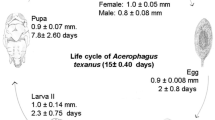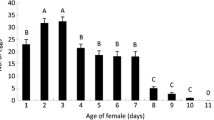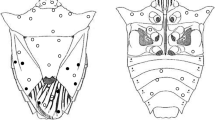Abstract
The lifecycle of Brachymeria podagrica, a parasitic wasp with a worldwide distribution, was studied under laboratory conditions using the flesh fly, Sarcophaga dux, as a host. Two hundred parasite-free 3rd instars of S. dux were exposed for 24 h to 20 female B. podagrica. In daily intervals, maggots and later pupae were examined for developmental stages of the parasitoid. The whole pre-imaginal development at a temperature of 26 °C lasted 21 to 26 days. Three morphologically different instars, followed by a prepupal and a pupal stage, were described using light and scanning electron microscopy. In a second experiment with 100 3rd stage Sarcophaga larvae and 10 parasitoids, a total of 70 wasps emerged 20 to 25 days after exposure. Two fly larvae did not pupate and dried out, while 28 pupae contained a dry or caseous content, dead wasp imagos, or their larval stages. No fly imagines emerged from exposed groups, while all 100 unexposed larvae pupated and adults eclosed between day 12 and day 14 after the start of the experiment, while the imagoes of the parasitoids appeared 8 to 12 days later.













Similar content being viewed by others
Data availability
Not applicable.
Notes
In this paper, the author named the species Chalcis fonscolombei.
In this paper, the author named the species Brachymeria fonscolombei which is according to Delvare and Huchet (2017) considered one of the 26 synonyms of B. podagrica.
References
Adhikari K, Khanikor B, Sarma R, Mahanta S, Kalita J (2016) Study on the life history and protein content of Sarcophaga ruficornis (Diptera: Sarcophagidiae) a forensically important insect. J Zool Stud 6:1–8
Al Galil FMA, Al-Keridis LA, Al-Mekhlafi FA, Al-Amri AM, Al-Khalifa MS (2022) First record of Brachymeria podagrica (Hymenoptera: Chalcididae) in Bisha city, Asir region, Saudi Arabia. J Med Entomol J Med Entomol 59:1556–1561. https://doi.org/10.1093/jme/tjac080
Al-Shareef LAH, Al-Qurashi SID (2016) Study of some biological aspects of the blowfly Chrysomya albiceps (Wiedemann 1819) (Diptera: Calliphoridae) in Jedda, Saudi Arabia. Egypt J Forensic Sci 6:11–16 10.1016j.ejfs2015.06.003
Amendt J, Krettek R, Niess C, Zehner R, Bratzke H (2000) Forensic entomology in Germany. Forensic Sci Int 113:309–314
Amoudi MA (1993) Effect of temperature on the developmental stages of Wohlfahrtia nuba (Diptera:Sarcophagidae). J Egypt Soc Parasitol 23:697–705
Badenhorst R, Villet MH (2018) The use of Chrysomya megacephala (Fabricius, 1794) (Diptera: Calliphoridae) in forensic entomology. Forensic Sci Res 3:2–15. https://doi.org/10.1080/20961790.2018.1426136
Barros-Cordeiro KB, Pujol-Luz JR, Bao SN (2021) A study of the pupal development of five forensically important flies (Diptera: Brachycera). J Med Entomol 20:1–11. https://doi.org/10.1093/jme/tjab039
Carvalho Queiroz MM (1996) Temperature requirements of Chrysomya albiceps (Wiedemann, 1819) (Diptera, Calliphoridae) under laboratory conditions. Mem Inst Oswaldo Cruz 91:785–788
Delvare G (2017) Order Hymenoptera, family Chalcididae. In: van Harten A (ed) Arthropod fauna of the UAE 6. Department of the President’s Affairs, Abu Dhabi, pp 225–274
Delvare G, Huchet J-B (2017) Brachymeria mochica, a new Neotropical species of Chalcididae (Hymenoptera: Chalcidoidea) discovered on the archaeological site of Huacas de Moche, Peru with a review of related species. Zootaxa 4290(1):043–060. https://doi.org/10.11646/zootaxa.4290.1.2
Delvare G, Talaee L, Goldansaz SH (2011) New Chalcididae (Hymenoptera: Chalcidoidea) of economic importance from Iran. Ann Zool 61:789–801. doi.org. https://doi.org/10.3161/000345411X622598
Dowen PB (1935) Brachymeria intermedia (Nees), a primary parasite, and B. compsilurae (CWFD), a secondary parasite of the gypsy moth. J Agricult Res 50:495–523
El-Kassem Bossly HA (2021) Development of Chrysomya albiceps (Wiedemann, 1919) (Diptera: Calliphoridae) from the Jazan region of Southwest Saudi Arabia under different laboratory temperatures: application for forensic entomology. Egypt J Forensic Sci 11:30 10.11.86?s41935-02100245-3
Frederickx C, Dekeirsschieter J, Verheggen FJ, Haubruge E (2013) The community of Hymenoptera parasitizing necrophagus Diptera in an urban biotope. J Insect Sci 13:32, available online: http://insectscience.org/13.32
Gabre RM, Adham FK, Chi H (2005) Life table of Chrysomya megacephala (Fabricius) (Diptera: Calliphoridae). Acta Oecol 27:179–183
Geden CJ, Rutz DA, Miller RW, Steinkraus DC (1992) Suppression of house flies (Diptera: Muscidae) on New York and Maryland dairies using releases of Muscidifurax raptor (Hymenoptera: Pteromalidae) in an integrated management program. Environ Entomol 21:1419–1426. https://doi.org/10.1093/ee/21.6.1419
Grassberger M, Frank C (2003) Temperature-related development of the parasitoid wasp Nasonia vitripennis as a forensic indicator. Med Vet Entomol 17:257–262
Iqbal T (2015) Taxonomic study of Chalcidididae (Chalcidoidea: Hymenoptera) of Khyber Pakhtunkhwa – Pakistan. PhD thesis. University of Peshewar, p 132
Machtinger ET, Geden, CJ Leppla NC (2015) Linear dispersal of the filth fly parasitoid Spalangia cameroni (Hymenoptera: Pteromalidae) and parasitism of hosts at increasing distances. PLoS One; 10: e0129105. doi: https://doi.org/10.1371/journal.pone.0129105
Parker H-L (1923) Contribution a la connaissance de Chalcis fonscolombei Dufour [Hym.]. Bull Soc Entomol France 29:238–240
Parker H-L (1924) Recherches sur les formes post-embryonnaires des chalcidiens. Ann Soc Ent France 93:262–379
Petersen JJ, Cawthra JK (1995) Release of a gregarious Muscidifurax species (Hymenoptera: Pteromalidae) for the control of filth flies associated with confined beef cattle. Biol Control 5:279–284. https://doi.org/10.1006/BCON.1995.1034
Raychoudhury R, Desjardins CA, Buellesbach J, Loehlin DW, Grillenberger BK, Beukeboom L, Schmitt T, Werren JH (2010) Behavioral and genetic characteristics of a new species of Nasonia. Heredity 104:278–288
Rivers DB (2016) Parasitic Hymenoptera as forensic indicator species. In: Shetty BSK and Padubidri JPR (eds) Forensic analysis – from death to justice. IntechOpen pp 67–83
Roberts RA (1933) Biology of Brachymeria fonscolombei (Dufour), a hymenopterous parasite of blowfly larvae. US Dept Agricult. Techn Bull 369:21
Salazar-Souza M, Couri MS, Aguiar M (2018) Chronology of the itntapuparial development of the blowfly Chrysomyya albiceps (Diptera: Calliphoridae): application in forensic entomology. J Med Entomol 55:825–832 10.1093?jme/tiy054
Schuster RK, Sivakumar S (2022) Natural infection of preimaginal stages of flies of the Sarcophagidae family with Brachymeria podagrica and Dirhinus himalayanus (Hymenoptera: Chalcididae) in the United Arab Emirates. Environ Anal Eco Stud 10(2):000734. https://doi.org/10.31031/EAES.2022.10.000734
Sukontason KL, Sanit S, Klong-klaew T, Tomberlin JK, Sukontason K (2014) Sarcophaga (Liosarcophaga) dux (Diptera: Sarcophagidae): a flesh fly species of medical importance. Biol Res 47:1–9. https://doi.org/10.1186/0717-6287-47-14
Villet MH, Muller WJ MKB (2006) Larval development of the carrion-breeding flesh fly, Sarcophaga (Liosarcophaga) tibialis Macquart (Diptera: Sarcophagidae), at constant temperatures. Afr Entomol 14:357–366
Voss SC, Spafford H, Dadour IR (2009) Hymenopteran parasitoids of forensic importance: host associations, seasonality and prevalence of parasitoids of carrion flies in Western Australia. J Med Entomol 46:1210–1219
Werren JH, Loehlin DW (2009) The parasitoid wasp Nasonia: an emerging model system with haploid male genetics. Cold Spring Harbor Protocols, p pdb.emo134. https://doi.org/10.1101/pdb.emo134
Zhang X, Li Y, Shang Y, Ren L, Chen W, Wang S, Guo Y (2020) Development of Sarcophaga dux (Diptera: Sarcophagidae) at constant temperatures and differential gene expression for age estimation of the pupae. J Therm Biol 93:102735 10.1016/j.jtherbio.2020.102735
Acknowledgements
The authors are very grateful to Mrs. Viertel from Institute for Zoo and Wildlife Research, Berlin, Germany, for excellent technical assistance with scanning electron microscopy. Special thanks go to Prof. Dr. S. Rehbein from Boehringer-Ingelheim, Rohrdorf, Germany, for his help in the acquisition of historical literature sources. The authors thank Dr. El-Mahi El-Tilib Gubran and his colleagues from the pest control section of Dubai Municipality for the determination of the Sarcophagidae eclosed from the pupae of the control group.
Author information
Authors and Affiliations
Contributions
R. Schuster: study design, light microscopy, and manuscript; G. Wibbelt: scanning electron microscopy and manuscript; S. Sivakumar: insectary work, light microscopy, and measurements.
Corresponding author
Ethics declarations
Ethics approval
Not applicable.
Consent to participate
Not applicable.
Consent for publication
Not applicable.
Competing interests
The authors declare no competing interests.
Additional information
Section Editor: David Bruce Conn
Publisher’s note
Springer Nature remains neutral with regard to jurisdictional claims in published maps and institutional affiliations.
Rights and permissions
Springer Nature or its licensor (e.g. a society or other partner) holds exclusive rights to this article under a publishing agreement with the author(s) or other rightsholder(s); author self-archiving of the accepted manuscript version of this article is solely governed by the terms of such publishing agreement and applicable law.
About this article
Cite this article
Schuster, R.K., Wibbelt, G. & Sivakumar, S. On the life cycle of Brachymeria podagrica (Fabricius, 1787) (Hymenoptera: Chalcididae) – a parasitoid of sacrophagid, calliphorid, and muscid flies. Parasitol Res 122, 1317–1325 (2023). https://doi.org/10.1007/s00436-023-07831-5
Received:
Accepted:
Published:
Issue Date:
DOI: https://doi.org/10.1007/s00436-023-07831-5




